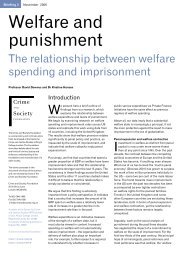PRISON SERVICE
PRISON SERVICE
PRISON SERVICE
- No tags were found...
Create successful ePaper yourself
Turn your PDF publications into a flip-book with our unique Google optimized e-Paper software.
prisoners and regular damage to property by smashingand/or burning out cells. They have caused significantoperational management issues for Governors andaffecting adversely, the regime/quality of life for themajority of prisoners. Some become psychotic anddelusional when they are under extreme stress. All suffersignificant emotional distress that the have previouslymanaged by offending and/or developing drug andalcohol addictions by attempting to self-medicate thesymptoms associated with their personality disorder.Some have long histories of self-mutilation and suicideattempts. A strategy that such prisoners use, is to be inand out of gated-cells and healthcare; regularly takingoverdoses, use ligatures or deep self-lacerations.Prisoners with severe personality disorder are also proneto conditioning staff and several have developedinappropriate relationships with officers, teachers, nursesand/or psychologists.Offending BehavioursThe men who reach criteria for the service mostoften begin offending at a young age. They tend tocommit a diverse range of offences which increase inseriousness. Their index offences are predominantlymurder, manslaughter, extreme violent assaults, rapeand/or sexual assault but most have committed morethan one such offence. Chart 1 indicates the indexoffences for the first cohort that completed thetreatment programme.12108CHART 1Index OffencesAssessmentOn The Fens Unit assessment is carried out by takingin groups of 6 to 8 men onto the unit. Assessmentconsists of undertaking a review of all collateraldocuments available on each prisoner, individualinterviews with prisoners conducted by psychologists anda psychiatrist and daily officer-led group-work. Thepurpose of the group work is to closely observe andrecord the prisoners interpersonal behaviour and for theprisoners to learn to work in a group and to establishgroup identity. The process takes 16 to 20 weeks. Tomeet criteria the prisoner must: — be a high risk of reoffending (measured by RiskMatrix 2000, Static 99, VRS, HCR-20, and SARN) have a severe personality disorder (measured byIPDE and PCL-R) have a link between his personality pathology andthe offences he commits (assessed by thecombination of detailed offence analysis and clinicaldevelopmental history).Those who reach criteria carry on working togetheras a group throughout treatment. Those that do notreach criteria or who refuse a treatment place arereturned to the referring prison with a detailedassessment report. The following charts 3-5 indicate themajor findings for the first cohort of prisoners whocompleted treatment.These statistics indicate that these are a particularlydifficult group of men. They present at a high risk ofreoffending yet their personality psychopathologywould exclude them from standard prison programmes.They are therefore exactly the group that the servicewas set up to treat.Treatment Programme642086420Murder Manslaughter Sexual Violence Other Violence FalseImprisonmentCHART 2Prisoners’ Scores on PsychopathyChecklist (PCL-R Scores)>30 27-29 24-26 21-24Score on Psychopathy Check ListWhilst traditional accredited prison treatmentcourses work well for many offenders to help reducetheir offending behaviours, men who reach criteria fortreatment within the Dangerous and Severe PersonalityDisorder Units have either been excluded from thoseaccredited prison programmes by virtue of theirpersonality psychopathology (PCL-R Score exceeding28) or have completed standard offending behaviourprogrammes and yet are perceived to continue to posea high risk of re-offending. The treatment programmedevised was rigorously scrutinised and agreed by anInternational Group of Experts in this field and thus hasbeen subjected to similar analysis to accredited prisonprogrammes.As offending behaviour and level of risk isconnected to personality pathology, unless thatpersonality pathology is addressed, at times of stress46 Prison Service JournalIssue 192











